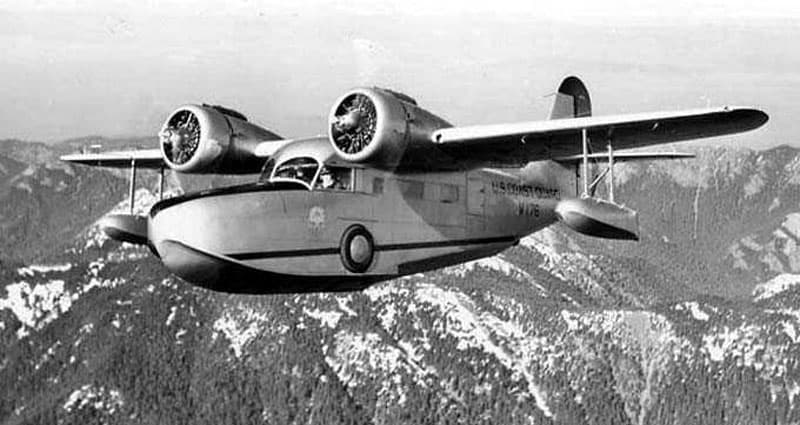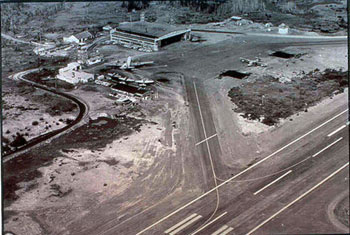 In the years leading up to World War II the thought was that any major operations by an enemy in the Alaska-Aleutian area was highly improbable. By April of 1940 the anxiety level had increased and it was concluded that there was a need for development of permanent installations at Kodiak, Sitka, Unalaska, Anchorage, and Fairbanks. Traffic through ports on the Pacific coast became extremely heavy. At Seattle in particular, facilities were stretched to their limits, and the American forces began discussions with Canada for using Canadian ports for shipment of troops and materials to Alaska. The build-up also required improved air service between the States and Alaska. In order to provide for larger and faster aircraft an airport with runways was needed as a refueling station between Seattle and Anchorage. Annette Island, a flat boggy island of about ten square miles, located twenty-five miles south of Ketchikan, was chosen as the site for a ten-thousand-foot runway. Construction started in the fall of 1940 and the first aircraft landed on the not-quite- complete runway in September of 1941. An important American embarkation port and ammunition dump was opened at the port of Prince Rupert, Canada in April 1942 but Canada’s ability to defend it against attack was very limited. The air base at Annette provided a location for defensive air support. Canada offered to supply a squadron of fighters to Annette, and by May 5, 1942, No. 115 (Fighter) Squadron was in place, becoming the first Canadian force ever based in U.S. territory to directly assist in American defense.
In the years leading up to World War II the thought was that any major operations by an enemy in the Alaska-Aleutian area was highly improbable. By April of 1940 the anxiety level had increased and it was concluded that there was a need for development of permanent installations at Kodiak, Sitka, Unalaska, Anchorage, and Fairbanks. Traffic through ports on the Pacific coast became extremely heavy. At Seattle in particular, facilities were stretched to their limits, and the American forces began discussions with Canada for using Canadian ports for shipment of troops and materials to Alaska. The build-up also required improved air service between the States and Alaska. In order to provide for larger and faster aircraft an airport with runways was needed as a refueling station between Seattle and Anchorage. Annette Island, a flat boggy island of about ten square miles, located twenty-five miles south of Ketchikan, was chosen as the site for a ten-thousand-foot runway. Construction started in the fall of 1940 and the first aircraft landed on the not-quite- complete runway in September of 1941. An important American embarkation port and ammunition dump was opened at the port of Prince Rupert, Canada in April 1942 but Canada’s ability to defend it against attack was very limited. The air base at Annette provided a location for defensive air support. Canada offered to supply a squadron of fighters to Annette, and by May 5, 1942, No. 115 (Fighter) Squadron was in place, becoming the first Canadian force ever based in U.S. territory to directly assist in American defense.
Annette Island became a transit base for aircraft being relocated throughout Alaska. On June 3, 1942, a large carrier-based Japanese force attacked Dutch Harbor, and resulted in a huge increase in activity. Air traffic at the Annette base became quite heavy at times, with C-47 transports, Canadian PBY-5 Cansos, Bristol Bolingbroke bombers, Norsemen utility aircraft, and P-40 fighters.
A U.S. Coast Guard Aviation Detachment was established at Annette Island on 14 March 1944. It consisted of two pilots, five enlisted crew members,

and one Grumman JRF amphibian. Personnel were billeted in the Civil Aeronautics Administration (CAA) Quonsets. The CAA provided hangar and office space. At the end of the war the several commercial airlines including Pan American resumed expanded operations.
In June 1946 a second JRF, pilot and crewmen arrived. In November of 1947 a PBY-5A was assigned, however PBY operations were discontinued in March of 1948. In the fall of 1952 UF-1G Albatross aircraft replaced the JRFs and the number of assigned personnel assigned to the Air Detachment increased. Ownership of the hanger was transferred to the Coast Guard in 1956. A BOQ/BEQ building was added in 1961 and families began moving into the newly constructed Roland Village Housing site at Tamgrass Harbor in 1965. The Air Station had grown to 83 enlisted personnel, 18 pilots operating three Grumman Albatrosses and two Sikorsky HH-52A amphibious helicopters. Replacement of both the HU16E and HH52A type aircraft with the HH3F helicopters commenced in 1972. In 1977 the Coast Guard Air Station was relocated from

Annette Island to Sitka, Alaska which was more centrally located in the Southeastern Alaska operating area.
